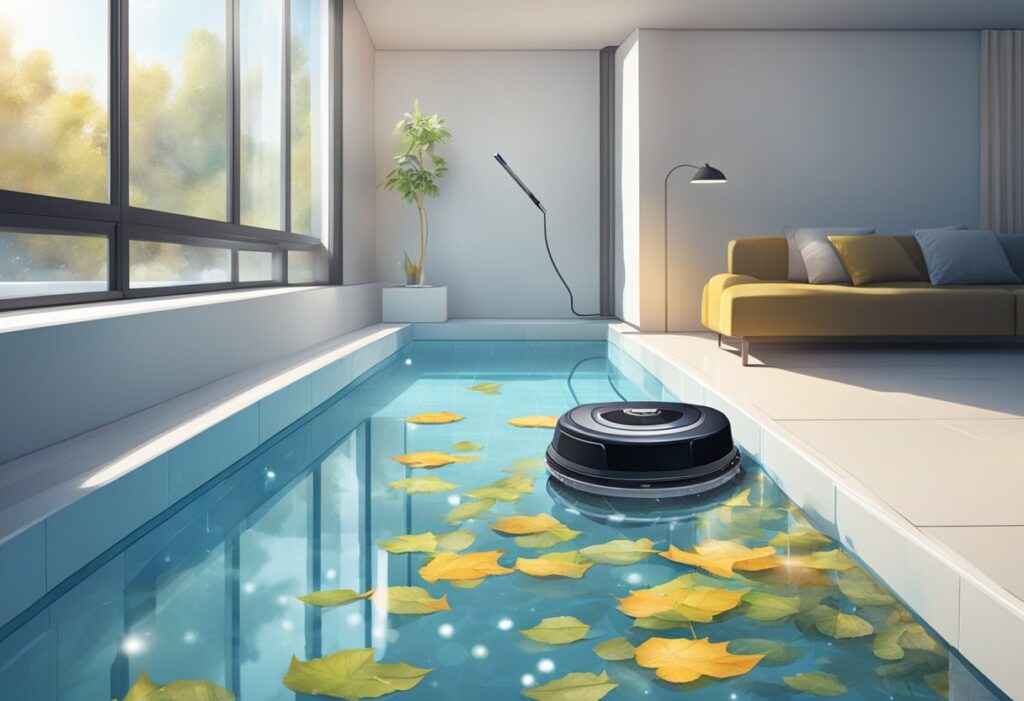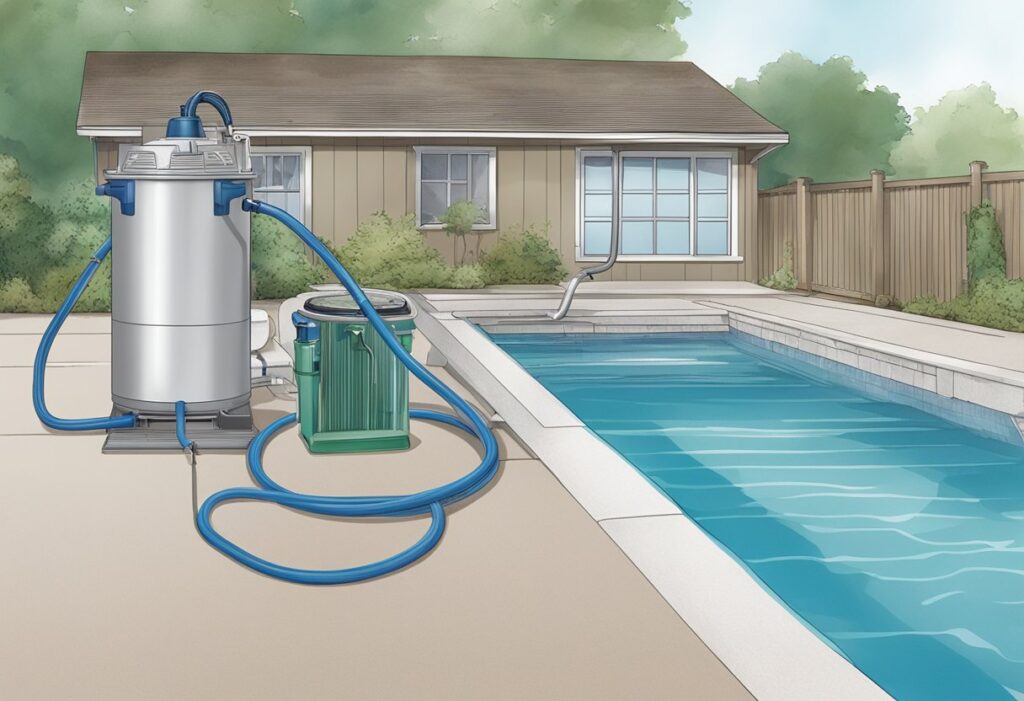Maintaining a clean swimming pool is essential for both the health and enjoyment of its users. A key part of this routine maintenance is vacuuming the pool to remove debris, dirt, and algae from the water. The process not only ensures the aesthetic appeal of your pool but also prolongs the life of your pool’s filtration system. A swimming pool vacuum is a simple tool that can make this task efficient and hassle-free.

To vacuum your pool quickly, you’ll require a pool vacuum or pool vac, which generally consists of a vacuum head, a vacuum hose, and a telescopic pole. The pole allows you to reach the depths of your pool comfortably, while the vacuum head does the work of lifting dirt off the bottom. Connecting the vacuum hose to the skimmer draws water through the pool vac, capturing debris as you guide it across the surfaces.
Before beginning, ensure your pool’s filtration system is turned on and set to the correct function to support the vacuuming process. Clearing floating debris with a net beforehand can minimise clogging and maintain strong suction. As you navigate the pool vac across the floor of your swimming pool, be methodical and overlap your paths to catch any missed spots. By following a consistent pattern, you can achieve a clean pool in a timely manner.
Preparing Your Pool for Vacuuming
Before diving into vacuuming your pool, it’s crucial to prep your pool by checking the filter and water level, adjusting your filter setting, and clearing out debris from the skimmer and pump strainer.
Check Pool Filter and Water Level
Ensure your pool’s water level is adequate; ideally, the water should reach halfway up the skimmer box opening to prevent air from entering the system and potentially damaging the pump. Next, inspect your pool filter system; if you have a sand filter, it might need backwashing if the pressure gauge reads 8-10 PSI above the normal operating level.
Adjust Your Filter Setting for Vacuuming
For an efficient vacuuming process, set your filter valve to the appropriate setting. If you’re operating a manual vacuum and expect minimal debris, the filter setting should typically be left on “filter”. However, if you anticipate a significant amount of debris, setting the filter valve to “waste” allows debris to bypass the filter and prevents clogging, though this may lead to some water loss.
Clearing Debris from Skimmer and Pump Strainer
Before vacuuming, remove any large debris from your pool skimmer basket and pump strainer. Doing so ensures unobstructed water flow and prevents potential blockages in the vacuuming process.
- Skimmer Basket: Open the skimmer lid, extract the basket, and discard any collected material.
- Pump Strainer: Shut off the pump, open the strainer lid, and clean out any debris present.
Remember to securely replace the skimmer basket and pump strainer before starting your vacuum. If using a skimmer plate, attach the vacuum hose to it after clearing the skimmer basket.
Equipment Setup

Prior to beginning the vacuuming process, it’s essential to have your equipment properly assembled and primed. Here’s how you can set up your vacuum apparatus efficiently.
Assembling the Vacuum Apparatus
Firstly, locate your vacuum head, telescopic pole, and vacuum hose. These three components are fundamental to your pool vacuum setup. Ensure that each part is in good working condition and free from any damage that could hinder their effectiveness.
Attaching the Vacuum Head to the Pole
- Secure the vacuum head to the open end of the telescopic pole.
- If the connection feels loose, use a hose clamp to tighten and secure the vacuum head to the pole. This will prevent any disconnection while you clean the pool.
Prime the Vacuum Hose with Water
- Submerge the vacuum head, attached to the telescopic pole, into the pool, ensuring it reaches the bottom.
- Before you connect the vacuum hose to the pump, you’ll need to fill it with water to prime it. This removes all the air and prevents air pockets from entering the pump.
- Feed one end of the vacuum hose into the water, and place the other end against the return jet or use a garden hose to fill it until water flows from the vacuum head, signalling that the hose is fully primed.
The Vacuuming Process
When you vacuum your pool, you ensure a thorough clean by starting from the shallow end, moving in a systematic grid pattern, and keeping an eye on the filter pressure to maintain optimal performance.
Starting from the Shallow End
Begin the process at the shallow end of the pool. This allows you to methodically work towards the deep end, pushing debris ahead of you. As the shallow end typically accumulates less debris, starting there provides an easier initial phase which gradually increases in difficulty as you approach the deeper sections, preventing you from stirring up the water and clouding the pool.
Vacuuming in a Grid Pattern
Vacuum your pool in parallel strokes, much like mowing a lawn, to cover the entire area systematically. These linear strokes should overlap slightly to ensure no spots are missed. By treating the pool’s bottom like a grid, you avoid leaving any uncleaned areas. A consistent and unhurried pace will give the best results, preventing debris from being missed or kicked up into the water.
Monitoring Filter Pressure Throughout
As you vacuum, keep an eye on your pool’s filter pressure. An increase in pressure may indicate that the vacuum is picking up a significant amount of debris. Conversely, if the pressure decreases, it suggests a possible blockage at the suction vent or that the pool’s pump basket needs to be emptied. Regular monitoring helps you adjust your vacuuming if needed to maintain a clean pool without overburdening the filtration system.
Aftercare and Maintenance
Proper aftercare and maintenance are essential following a thorough pool vacuum to ensure your pool remains pristine and the equipment functions correctly.
Backwashing the Filter After Vacuuming
After vacuuming your pool, it’s crucial to backwash the filter, which will remove any accumulated debris from the filter system. Locate the filter’s valve and set it to the ‘backwash’ position. Watch the sight glass; when the water runs clear, your backwash cycle is complete. Here’s a simple guide:
- Turn off the pool pump.
- Set the valve to ‘backwash’.
- Turn on the pump and observe the sight glass.
- Once the water is clear, turn off the pump.
Checking and Cleaning the Equipment
Regularly inspect your vacuum equipment to ensure it’s in good order:
- Filter Bag: For automatic pool cleaners, check the filter bag or canister for rips or blockages post vacuuming and clean it out accordingly. This prevents damage and maintains suction efficiency.
- Vacuum Hose: Inspect for cracks or leaks, and ensure the hose is free from obstructions, as this can impact pool cleaning performance.
- Skimmer Basket: Empty and rinse out the skimmer basket to prevent clogs in the system.
By following these aftercare steps, you’ll extend the lifespan of your pool equipment and keep your pool in top condition.











